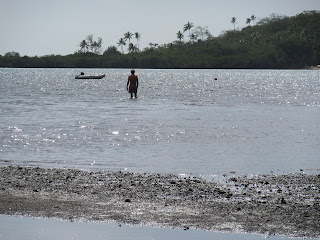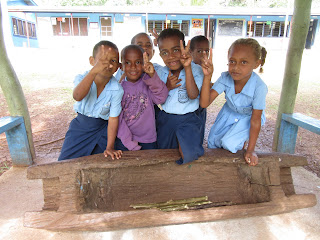The north coast of
Vanua Levu, Fiji’s second largest island, was one of our primary
destinations this season. It is so rarely visited by cruising
sailboats that in some locations we were the first vessel to visit
this year, and in others we were the first they had ever seen.
Exploring and immersing ourselves in remote and beautiful places, we found what we came for.
A Month in Pictures:
Exploring and immersing ourselves in remote and beautiful places, we found what we came for.
A Month in Pictures:
Women
in the village of Naviqiri spending a hot afternoon weaving mats for
their homes.
When
we played for them, the woman on the far right (also pictured above)
got up and started dancing.
There really is one in every crowd!
We arrived during a “trade wind surge”, with winds much stronger than normal. Shallow anchorages with mud bottoms were good for holding the anchor securely, but we still left our anchor alarm on all the time and did not even leave the boat for a few days. (For geeks: the inner “smudges” are from the first night, leaving marks where our boat had floated. When wind increased, we reset the alarm distance then let out more chain, which left marks further away from the anchor location.)
Despite the wind, skies were clear—and the timing was perfect for outstanding sights of rising and setting moons and suns. We were also able to consistently observe four planets trace one arc across the night sky. I don’t know what I’d say about watching grass grow, but watching the world turn is truly satisfying.
The
village of Naqumu is literally up a creek. To get there, one can plod
through mud at low tide,
or
wade out nearly waist deep at high tide. (For skeptics: no, it’s
not possible to time all coming and going at mid-tide only.)
After
the church service we attended, the adults stayed inside for a
meeting.
The children followed us outside, joined by the village
chief—all in their Sunday best.
We found we could sing along with the hymns! With a grasp of Fijian pronunciation and an ear for harmony, it was easy to join in—plus a couple of the tunes were already familiar. A photo of a hymnal page shows the notes, written in solfege. (For musicians: you, too, can read and sing along!)
 |
Some
kindies ( kindergarteners) wanted to pose around the
lali.
These drums are still
almost universally used as village clocks, calling people to
school/church, lunch, meetings, etc.
Naqumu
children get to school along this road. High tides can cover the
track, hence the logs and rocks.
Children from other villages arrive by boat. After we played for them, the passing “school boat” would come close to our boat in the morning, cheering and waving! (For the observant: the poles move the boat along when the water is too shallow to use the motor.)
Kia Island lies out at the far edge of Cakaulevu, the Great Sea Reef.
Daku village, tucked onto its west shore, was one of the most
picturesque villages we saw anywhere.
Many
of the young men would spend hours standing in the surf, catching
fish for dinner and also to sell in Labasa.
The
water looked enticing but it was full of jellyfish! We tried swimming
but didn’t stay in long.
Us: “Do you ever get stung by the jellyfish?”
Kids fishing: “Yes.”
Us: “Does it hurt?”
Kids: “Yes.”
Us: “Do you ever get stung by the jellyfish?”
Kids fishing: “Yes.”
Us: “Does it hurt?”
Kids: “Yes.”
If
you want to eat, you get stung. Part of life.
Here’s the one in this crowd! (The woman on the left, not me. Oh wait, I guess I’m probably in that category now too.)
I
find it truly remarkable that everywhere we go, aging women have no
inhibitions; they get up and dance, with very suggestive hip and eye
movements. Everyone finds it hilarious, with much laughing and
whooping and clapping along.
(For older adults—no, for all ages—there is a lesson here.)
(For older adults—no, for all ages—there is a lesson here.)
Labasa,
one of the largest towns in Fiji, is the focus of administrative and
market activity on Vanua Levu.
It’s a working town, built around an
enormous sugar mill operation that opened in 1894.
When we took a bus
from the nearby anchorage into town, we passed miles of trucks loaded
with sugar cane.
Labasa
is also primarily Indo-Fijian, and the Indian influence is felt
everywhere from food and dress to temples.
Not far out of town is the
Nagigi Naag Mandir, or Snake Temple.
This
rock formation is shaped like a cobra head and has reputedly been
growing for decades. When I asked if it was permissible to take a
photograph, the priest offered to take a photo of both of us…
I
don’t need to post a picture of our curry meal, but shop windows
full of Indian clothing are worth seeing.
We
happened to show up on the last day of the Crime Prevention Festival,
celebrated by a parade complete with brass band, floats, and a large
crowd. Ironically, someone pickpocketed Art—at the Crime Prevention
parade, no less.
Fortunately he didn’t lose anything of much value,
so we just found the irony amusing.
The
market and bus station area was more than crowded:
it was a jumble of
people, packages, people, bundles, people, vendors, people… there
was barely room for us on the bus back to the village where our boat
was anchored, which made the ride even more festive.
A
turning point: Art celebrated his 65th birthday!
Twice, in fact.
Twice, in fact.
July
8 on this side of the date line,
we bought a tub of ice cream in Labasa and shared it at the park-like area along the river.
we bought a tub of ice cream in Labasa and shared it at the park-like area along the river.
July
8 on the USA side of the date line, we played for the small village
near where our boat was anchored.
It turns out Fijians have the same
birthday song, so everyone sang to him!
When we left, the kids
carried our dinghy back into the water for the “old man”. There
are way worse ways to turn 65.
The
weather at that point was calm enough that we felt it would be safe
to anchor at the edge of the Great Sea Reef.
I
haven’t posted any sunset photos in ages (too many? too
predictable?), but I couldn’t resist this one.
(For
the curious: there are a few too many clouds on the horizon to see
the green flash, but we did see an unexpectedly terrific one several
days earlier. One of these evenings I may get a photo to prove it…)
The
few lights near the reef pass we had seen from a distance turned out
not to be navigation lights, but a couple of small fishing boats
parked overnight. They use hooks and lines—very ecological—so
when they offered to sell us one,
we were happy to support them. It
provided four terrific dinners!
Though
there was no village at our Vatudamu Point anchorage, people travel
between villages by water and it turned out the Point was an
intersection of sorts, with several boats passing by every day. We
loved having them stop by to introduce themselves and chat! Our
presence was an event; people wanted to ask questions, and to see us
and our boat up close.
A
dinghy trip up the Wainikoro (“Water of the Village) River rounded
out our adventures along the north coast. It started out fairly wide,
though soon was more narrow and curved.
Occasionally
the thick mangroves parted to reveal a tunnel. If some random object
was tied at a tunnel entrance,
it meant something was up that creek:
in one case a village, in others access to an inland road.
This tunnel held the local school boat.
it meant something was up that creek:
in one case a village, in others access to an inland road.
This tunnel held the local school boat.
The end of a very good day
(For the envious: no, they
don’t all end this way!
But when they do, they make the challenges
of a voyaging life worthwhile...)



































